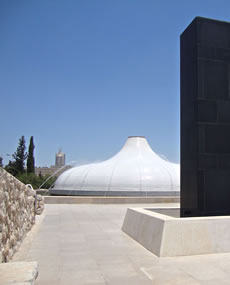Dead Sea Scrolls
Your faith is worth more than gold
~ 1 Peter 1:7
Study of the Dead Sea Scrolls has increased the faith of Bible-believers. Why? Because they prove that the hand-copied texts that have come down from the Masoretic scribes are accurate.
The Dead Sea is the lowest place on earth – 400 metres below sea level.
The exceptionally dry climate meant that the hidden scrolls could better survive the ravages of time.

Printed Bibles have been in use for about 500 years. Prior to that, copies of the Scriptures were hand-written. Each Bible was a copy, made from a previous copy. No original texts were preserved. In fact, the oldest copy in existence, until the discovery of the Dead Sea Scrolls, dates back about 1,100 years. The question could always be asked: How can we know that errors did not occur in the copying?
The Dead Sea Scrolls, discovered in the years 1947 to 1956, in eleven caves near Qumran, have answered that question. The Scrolls can be positively dated. They are 1000 years older than previously used manuscripts — and yet the text shows no deviation.
The Masoretic scribes who made the copies kept a remarkably accurate record.
It is another proof that the Hebrew Bible is trustworthy. It is the Word of God, as delivered by Him and preserved by Him.
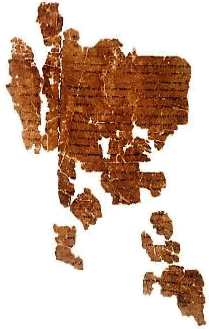
A fragment of the scroll of the book of Exodus dated to approximately 100 BC.
The text is Exodus 6:25-7:19 in palaeo-Hebrew script.
Dating the Dead Sea Scrolls
The Dead Sea Scrolls are noteworthy because they prove the integrity of the Hebrew Bible. What is significant is that the Scrolls can be positively dated to around 100 BC, which makes them a thousand years older than the oldest texts previously available.
How are the Scrolls dated?
- Scholars are able to date the ancient Hebrew script, known as palaeo-Hebrew. There is no doubt about the period when this writing was in use.
- Historical references in the non-biblical scrolls of the Essenes show that they were living in herodian times.
- Archaeological evidence gives us positive dates for when the Essenes were living at Qumran.
- Carbon-14 tests
- Coins found with the Scrolls can be definitely dated.
Seleucid tetradrachms minted in Tyre date to about 120 BC. Shekel and half-shekel coins were minted from 125 BC onwards. They were the coins prescribed for the Temple poll tax. Roman coins from around 50 BC were among the hoard, and there were some coins that could be dated to around 10 BC.

Silver coins
These silver coins were part of a hoard of 561 shekel and half-shekel coins found in vessels under a doorway at Qumran.
What was found?
The Dead Sea Scrolls were found in the years 1947 to 1956 in eleven caves near Qumran on the northwest shore of the Dead Sea — the lowest place, and one of the driest places, on earth.
The remains of about 800 scrolls were discovered. Some were substantially intact, including copies of the book of Isaiah. However, most survived only as fragments and assembly was painstaking and difficult – rather like working on vast jigsaw puzzles with many of the pieces missing.
The Scrolls were from the library of the monastic Essenes – a Jewish sect in Israel. During the First Jewish Revolt from 66AD to 73AD, the Essenes hid their valuables and fled from the Roman army. The treasure was preserved for 1900 years.
The Judean wilderness around the Dead Sea is riddled with caves and hiding places.
The settlement of the Essenes at Qumran was located above the gorge running from the mountains to the Dead Sea.
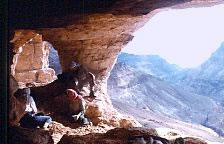
About 190 of the 800 scrolls were from every book of the Hebrew Bible, except the book of Esther. The most popular biblical books were Isaiah, Psalms, Deuteronomy and Genesis. The non-biblical manuscripts included hymns, commentaries, rules for communal life, military manuals and theological works.
Study of the Scrolls
At the time of the discovery of the Scrolls the area was controlled by Jordan. Seven scholars were assigned to assemble the fragments. Six were Catholic clerics. The seventh was an agnostic. Protestants and Jews were excluded.
It took until the late 1950’s to substantially complete the work of assembly. Then the team divided the 500 different texts among themselves for publication – an act of enormous scholarly pride and greed, because this was far more work than anyone could possibly have completed in a lifetime. Only one scholar ever published his entire assignment, but the work was so bad that an article correcting it is longer than his original publication. Over the next thirty years the team managed to publish less than twenty per cent of the texts.
Scholars in the 1950’s studying fragments of the Dead Sea Scrolls
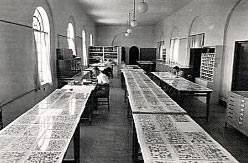
There was great dissatisfaction from excluded scholars around the world, and the delays fuelled controversies and speculation that ran in the popular press in the 1990’s.
Israel had acquired a handful of scrolls by purchase in 1947, and others in 1954. They gained administration of the entire project when they defeated Jordan in the 1967 Six-Day War. However, Israel was unwilling to risk international criticism, so the scholars continued to guard their “right” to the hoard of texts. It was not until 1991, when various pressures, and the publication of computer reconstructed photographic transcripts of the Scrolls, made the entire collection generally available.
Today, anyone can purchase a copy of all the Scrolls and more than 50 international scholars – Catholic, Protestant, Jewish and secular – have been working on the project.
The mystery has gone out of the affair – and with it, public interest.
However, for the Bible-believer, we can say that the study of the Dead Sea Scrolls will give:
- The knowledge that Christianity is grounded more deeply in Jewish thought than was supposed for many centuries.
- Confirmation that the Hebrew Bible, used by Jews and Christians today, is the same as that quoted by Jesus.
The ancient scribes
Before the introduction of printing, some 500 years ago, scrolls and books had to be copied by hand. Scribes worked at this task from the earliest days. Jewish scribes developed their traditions and practices from the time of Moses, through the Babylonian captivity, through the time of Jesus and into the Middle Ages when they were called Masoretes.
They were not allowed to write anything from memory. They took a ritual bath before starting and they could not be disturbed – even by the king. After copying, every word and letter had to be counted to check against the original. If they did not match then the copy was destroyed.
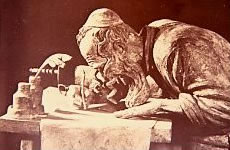
Hebrew scribes spent their lives copying the biblical texts
Scribes had to be strictly observant Jews and had to follow meticulous rules in their work.
No originals remain. The earliest copies that we have – prior to the discovery of the Dead Sea Scrolls – were copies of copies of copies. They are the Cairo Codex (895 AD), the St Petersburg Codex (916 AD), the Aleppo Codex (929 AD) and the British Museum Codex (950 AD).
The Dead Sea Scrolls pre-date these texts by nearly one thousand years, and prove how remarkably accurate the scribes have been through the ages.
The archaeological dig at Qumran.
The Dead Sea Scrolls were found in caves around the site of this monastic settlement of the Essenes. Clay inkwells and reed pens were found in the ruins.
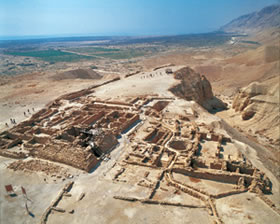
Controversies surrounding the Dead Sea Scrolls
The complicated job of piecing the scroll fragments together, and scholarly pride in not sharing their work, led to a delay of forty years in publishing the substantial findings of the Dead Sea Scrolls. In the late 1980’s speculation began to grow that the Catholic scholars who were controlling the assignment were attempting to hide evidence that would discredit Christianity.
The dramatic story of the finding of the Scrolls, and the secrecy and mystery surrounding the study of them, gave fuel to the popular press. Wild ideas were put forward as to whether the Scrolls were medieval forgeries or whether Jesus, Paul and John the Baptist were identifiable in the writings. Others speculated that forgotten gospels, or omitted biblical texts, had been found and some believers worried that perhaps their faith in the Bible might be undermined.
Pottery jars of a type found nowhere else.
These unique jars were found in the excavations at Qumran and also in the caves where the Dead Sea Scrolls were hidden.
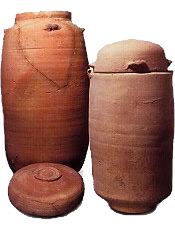
Cashing in on the public interest, several authors published books in the early 1990’s containing contrived stories questioning the New Testament account and claiming the Dead Sea Scrolls as evidence for their theories.
Without addressing all the suppositions of these now discredited writers and theologians, it can be stated that their ideas are in complete disagreement with those of today’s scholars.
Christians need not fear attacks upon their faith. It rests on a solid foundation.
In just one example, Barbara Thiering composed a bizarre story that Jesus survived the crucifixion, married twice and died in Rome. She labelled Him the ‘Wicked Priest’ and the ‘Liar.’ She said that John the Baptist was the ‘Teacher of Righteousness.’ However, the scroll mentioning the ‘Teacher of Righteousness’ is dated at least 100 years earlier than the time of Jesus. The scroll describes the ‘Wicked Priest’ as a ruler of Israel, corrupted by wealth and power. No Jewish, Christian or non-affiliated scholar has ever claimed that Jesus was the ruler of Israel or was corrupted by wealth!
To give another example, the Essenes were separatists. Jesus was not. And neither was John the Baptist. They did not lock themselves away from the world but mixed with ordinary people, including those that their society abhorred, like prostitutes and tax-collectors. Jesus, John the Baptist and the apostles could not have been associated with the separatist Essene sect.
Christians need not fear attacks upon their faith. It rests on a solid foundation.
New Testament copies
We have 4,969 handwritten copies of portions of the New Testament. Some fragments can be dated to as early as 125 AD.
By comparison, there are only 643 copies of Homer’s Iliad, 49 copies of Aristotle’s Works, 20 copies of Livy’s History of Rome, and 10 copies of Caesar’s Gallic Wars. Liberal scholars try to discredit the Bible, but they accept these other works, with far fewer copies, as authoritative. They discredit themselves with such inconsistency.
No other writings from the past can be compared with the Bible in terms of overwhelming evidence”
While manuscript copies of Caesar’s Gallic Wars and Aristotle’s Works are about 1000 years old, there are New Testament copies, like the John Rylands Fragment, the Papyrus Bodmer II, the Codex Sinaiticus and the Codex Vaticanus that can be dated to between 1660 and 1890 years ago. No other writings from the past can be compared with the Bible in terms of overwhelming evidence.
God has preserved His Word for us. Our faith rests on a solid foundation.
Evidence that the Bible is the Word of God – Related messages:

